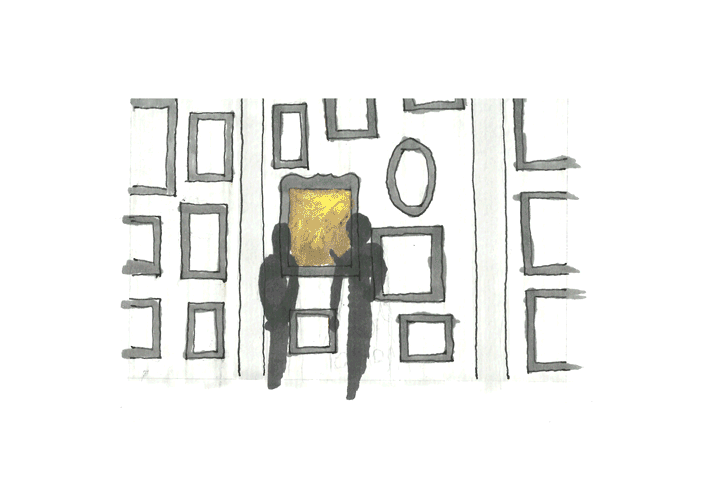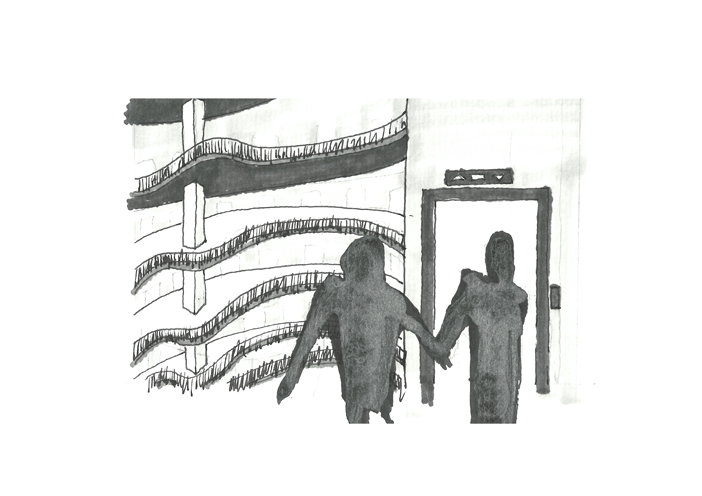This is a speculative vision for the American city of Boston in approximately the year 2100 BCE.
This is a work in progress. Please check back for revisions and additional information soon.
In the year 2100, Boston will be wildly different place than it is today. Many of the infrastructural, social, and commercial networks upon which the city relies are forecasted to be ever more distributed and decentralized. The population of the city is expected to dramatically balloon due to urban migration and displaced people across the greater Boston Census Survey Area. Perhaps most impactful is the likely impact of sea level rise on urban topology. The following speculation explores life in a future Boston, some of the buildings produced for this world, and meets some characters imagined to occupy this amphibious landscape.
I can faintly hear Valentina and a customer discussing a painting on the wall. I never understood people’s fascinating with that one. A solitary man standing in the water staring at the viewer…it was sad if anything.
The sun splashed through the screen of my little cubby and I turned the final page of Candid following the journey of the intrepid optimist.
Emerging from from the hidey-hole I spent so much time in, I hurried across the room realizing that I was late. The customer had taken the painting and I felt a pang of loss. For as much as I hated that she’d painted it, I liked the constant reminder of the encroaching deluge.
I was running late and tore through the house through the conservatory’s humid air to arrive at the stairs up to the skyway.
Slightly out of breath from all the stairs, I slowed my pace and strolled amongst the other people hurrying to work, the meandering couples, and the playing children.
The skyway cut through the city recovering the street systems raised into the air. As the city lifted its infrastructure and utilities into the air, streets found themselves not only inundated by water from below but increasingly made subterranean as a new ground materialized above…
Alex leaned perched on the edge of the walkway and smiled sidewise as I approached.
“What a day,” he sighed after a long pause. I asked what was on his mind, gazing back with a faint smile that he always teased me about. A smile that Telegraphed my interior transparently.
Our conversation meandered through everything and nothing as conversations have a habit of doing. I remember the sun warm on my face. Alex ran his fingers through my hair and I eagerly suggested that we return to his apartment.
Alex lived in the Fabergé Tower. As an employee of the Boston Resilience Project he was valuable to the city and it’s attempts to buttress itself and was afforded nice accommodations. We rushed eagerly up the stairs and spun around the narrow turnabouts as we ascended the tower.
Rushing, we made our way into the room; And as the door clicked shut behind us, Alex lifted my shirt off my head. I disappeared into him and for an eternity we were like the water. Floating.
I passed Alex a coffee, his crinkled brow signaled that our brief escape was over. “Everything will be alright?” he asked sitting down at the table, barely looking away from the city. “Right?”
I didn’t know if it was my family’s security, blind foolishness, or simply a reiteration of the lie we all tell ourselves, but before I knew what I was saying the words had escaped me: “Everything will be okay, because that is how is will be.”
A sharp rapping at the door snapped us back to reality. “We know you’re in there, Mr. Frobisher. Please open the door.”The controller of the tower had probably heard that Alex had left work earlier in the company of another man.
With haste, we threw on our clothes and slipped out the window and dropped onto the ramp which spiraled down to the skyway.
Passing through a developing crowd hurrying home or running errands, we enjoyed our rediscovered anonymity.
Stomachs growling, we grabbed some dinner and slipped into an alley to eat on the steps leading down to our meeting.
We rounded the corner and stepped from the main pathway on its stilts to a series of boards which had been placed haphazardly atop buckets, stacks of bricks, and general rubbish.
The door swung open and with a quick turn we were halfway down the steep stairs when the door clicked shut behind us. The large platform and table dominated the flooded chamber.
“Why are you guys always late,” a woman’s voice cut across the space reverberating against the metal, stone, and water. Catching up to Alex, I noticed that indeed everyone else had gathered about the table.
Alex pulled out a roll of drawings and spread them out before Dauphine at the end. We discussed a series of plans that Alex had brought with us and were excited that our group would begin construction on the community residences and hopefully the market soon. We’d hoped to finish by the end of the year.
After the meeting we found ourselves headed to a party down the street, hosted in an abandoned South End brownstone, converted into a strange club. We toasted, excited that our plans to construct the community market and the collective’s structure was moving forward.
In the ensuing years our structure grew in popularity and a vibrant community was built up around the market and in the adapted South End. The government was not always accommodating to our community organizing and in a series of events that are still shrouded in mystery. A resident of the structure was shot dead in the market one night when a police raid was sweeping through.
Her murder set off a horrible period of violence which ended in a placid armistice between the population of the city and the government. Despite the political difficulties, this period saw substantial development across the city as the model we’d instigated was replicated. Notable is the tower located above Chinatown. A chimeric collection of recovered buildings reassembled.
Despite these developments, or perhaps because of them, large areas of the city far from the skyways infrastructural spine and within the thickened ground under the newly elevated city were left largely unconsidered. The cities triple-decker homes were quickly destroyed by the rising water and in their place boat-makers and others began to construct a scaffold city amongst the structures around them.
In the end, we just wanted to see a better world… and tell better stories.












